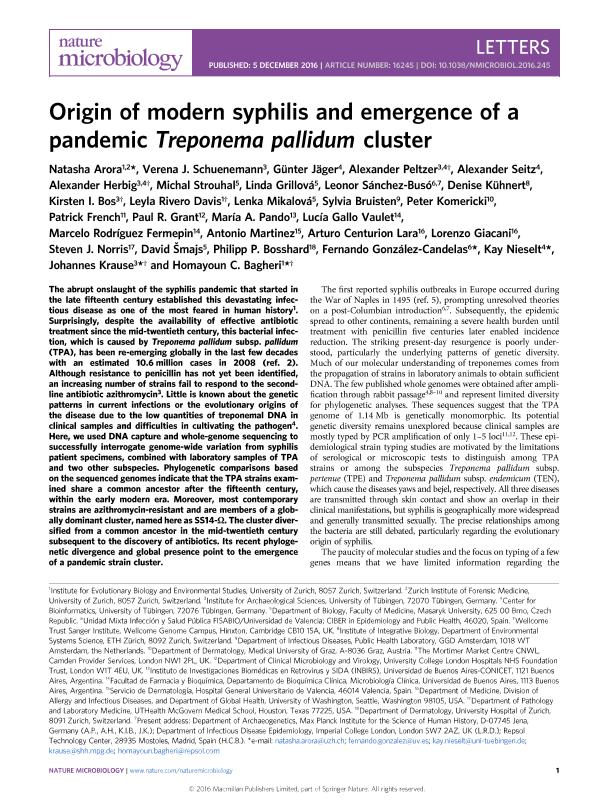Mostrar el registro sencillo del ítem
dc.contributor.author
Arora, Natasha
dc.contributor.author
Schuenemann, Verena J.
dc.contributor.author
Jäger, Hünter
dc.contributor.author
Peltzer, Alexander
dc.contributor.author
Seitz, Alexander
dc.contributor.author
Herbig, Alexander
dc.contributor.author
Strouhal, Michal
dc.contributor.author
Grillová, Linda
dc.contributor.author
Sánchez Busó, Leonor
dc.contributor.author
Kühnert, Denise
dc.contributor.author
Bos, Kirsten I.
dc.contributor.author
Davis Rivero, Leyla
dc.contributor.author
Mikalová, Lenka
dc.contributor.author
Bruisten, Sylvia
dc.contributor.author
Komericki, Peter
dc.contributor.author
French, Patrick
dc.contributor.author
Grant, Paul R.
dc.contributor.author
Pando, María de los Ángeles

dc.contributor.author
Gallo Vaulet, Maria Lucia

dc.contributor.author
Rodríguez Fermepin, Marcelo

dc.contributor.author
Martinez, Antonio
dc.contributor.author
Lara, Arturo Centurión
dc.contributor.author
Giacani, Lorenzo
dc.contributor.author
Norris, Steven J.
dc.contributor.author
Smajs, David
dc.contributor.author
Bosshard, Philipp P.
dc.contributor.author
González Candelas, Fernando
dc.contributor.author
Nieselt, Kay
dc.contributor.author
Krause, Johannes
dc.contributor.author
Bagheri, Homayoun C.
dc.date.available
2020-08-24T04:08:08Z
dc.date.issued
2016-11
dc.identifier.citation
Arora, Natasha; Schuenemann, Verena J.; Jäger, Hünter; Peltzer, Alexander; Seitz, Alexander; et al.; Origin of modern syphilis and emergence of a pandemic Treponema pallidum cluster; Springer; Nature Microbiology; 2; 16245; 11-2016; 1-6
dc.identifier.issn
2058-5276
dc.identifier.uri
http://hdl.handle.net/11336/112201
dc.description.abstract
The abrupt onslaught of the syphilis pandemic that started in the late fifteenth century established this devastating infectious disease as one of the most feared in human history1 . Surprisingly, despite the availability of effective antibiotic treatment since the mid-twentieth century, this bacterial infection, which is caused by Treponema pallidum subsp. pallidum (TPA), has been re-emerging globally in the last few decades with an estimated 10.6 million cases in 2008 (ref. 2). Although resistance to penicillin has not yet been identified, an increasing number of strains fail to respond to the secondline antibiotic azithromycin3. Little is known about the genetic patterns in current infections or the evolutionary origins of the disease due to the low quantities of treponemal DNA in clinical samples and difficulties in cultivating the pathogen4. Here, we used DNA capture and whole-genome sequencing to successfully interrogate genome-wide variation from syphilis patient specimens, combined with laboratory samples of TPA and two other subspecies. Phylogenetic comparisons based on the sequenced genomes indicate that the TPA strains examined share a common ancestor after the fifteenth century, within the early modern era. Moreover, most contemporary strains are azithromycin-resistant and are members of a globally dominant cluster, named here as SS14-Ω. The cluster diversified from a common ancestor in the mid-twentieth century subsequent to the discovery of antibiotics. Its recent phylogenetic divergence and global presence point to the emergence of a pandemic strain cluster.
dc.format
application/pdf
dc.language.iso
eng
dc.publisher
Springer

dc.rights
info:eu-repo/semantics/openAccess
dc.rights.uri
https://creativecommons.org/licenses/by-nc-sa/2.5/ar/
dc.subject
TREPONEMA PALLIDUM
dc.subject
ORIGIN OF SYPHILIS
dc.subject.classification
Enfermedades Infecciosas

dc.subject.classification
Ciencias de la Salud

dc.subject.classification
CIENCIAS MÉDICAS Y DE LA SALUD

dc.title
Origin of modern syphilis and emergence of a pandemic Treponema pallidum cluster
dc.type
info:eu-repo/semantics/article
dc.type
info:ar-repo/semantics/artículo
dc.type
info:eu-repo/semantics/publishedVersion
dc.date.updated
2018-06-06T13:37:25Z
dc.journal.volume
2
dc.journal.number
16245
dc.journal.pagination
1-6
dc.journal.pais
Estados Unidos

dc.description.fil
Fil: Arora, Natasha. Universitat Zurich; Suiza
dc.description.fil
Fil: Schuenemann, Verena J.. Eberhard Karls Universität Tübingen. Institute For Archaeological Sciences.; Alemania
dc.description.fil
Fil: Jäger, Hünter. Eberhard Karls Universität Tübingen.; Alemania
dc.description.fil
Fil: Peltzer, Alexander. Eberhard Karls Universität Tübingen.; Alemania
dc.description.fil
Fil: Seitz, Alexander. Eberhard Karls Universität Tübingen.; Alemania
dc.description.fil
Fil: Herbig, Alexander. Eberhard Karls Universität Tübingen.; Alemania
dc.description.fil
Fil: Strouhal, Michal. Masaryk University; República Checa
dc.description.fil
Fil: Grillová, Linda. Masaryk University; República Checa
dc.description.fil
Fil: Sánchez Busó, Leonor. Universidad de Valencia; España. University of Cambridge; Reino Unido
dc.description.fil
Fil: Kühnert, Denise. Universitat Zurich; Suiza
dc.description.fil
Fil: Bos, Kirsten I.. Eberhard Karls Universität Tübingen. Institute For Archaeological Sciences.; Alemania
dc.description.fil
Fil: Davis Rivero, Leyla. Universitat Zurich; Suiza
dc.description.fil
Fil: Mikalová, Lenka. Masaryk University; República Checa
dc.description.fil
Fil: Bruisten, Sylvia. Public Health Laboratory. Department of Infectious Diseases; Países Bajos
dc.description.fil
Fil: Komericki, Peter. Medical University of Graz; Austria
dc.description.fil
Fil: French, Patrick. The Mortimer Market Centre ; Reino Unido
dc.description.fil
Fil: Grant, Paul R.. University College London; Estados Unidos
dc.description.fil
Fil: Pando, María de los Ángeles. Consejo Nacional de Investigaciones Científicas y Técnicas. Oficina de Coordinación Administrativa Houssay. Instituto de Investigaciones Biomédicas en Retrovirus y Sida. Universidad de Buenos Aires. Facultad de Medicina. Instituto de Investigaciones Biomédicas en Retrovirus y Sida; Argentina. Universidad de Buenos Aires; Argentina
dc.description.fil
Fil: Gallo Vaulet, Maria Lucia. Universidad de Buenos Aires. Facultad de Farmacia y Bioquímica. Departamento de Bioquímica Clínica; Argentina
dc.description.fil
Fil: Rodríguez Fermepin, Marcelo. Universidad de Buenos Aires. Facultad de Farmacia y Bioquímica. Departamento de Bioquímica Clínica; Argentina
dc.description.fil
Fil: Martinez, Antonio. Hospital General Universitario de Valencia; España
dc.description.fil
Fil: Lara, Arturo Centurión. University of Washington; Estados Unidos
dc.description.fil
Fil: Giacani, Lorenzo. University of Washington; Estados Unidos
dc.description.fil
Fil: Norris, Steven J.. UTHealth McGovern Medical School. Department of Pathology and Laboratory Medicine; Estados Unidos
dc.description.fil
Fil: Smajs, David. Masaryk University; República Checa
dc.description.fil
Fil: Bosshard, Philipp P.. Universitat Zurich; Suiza
dc.description.fil
Fil: González Candelas, Fernando. Universidad de Valencia; España
dc.description.fil
Fil: Nieselt, Kay. Eberhard Karls Universität Tübingen.; Alemania
dc.description.fil
Fil: Krause, Johannes. Eberhard Karls Universität Tübingen.; Alemania
dc.description.fil
Fil: Bagheri, Homayoun C.. Universitat Zurich; Suiza
dc.journal.title
Nature Microbiology
dc.relation.alternativeid
info:eu-repo/semantics/altIdentifier/doi/http://dx.doi.org/10.1038/NMICROBIOL.2016.245
dc.relation.alternativeid
info:eu-repo/semantics/altIdentifier/url/https://www.nature.com/articles/nmicrobiol2016245
Archivos asociados
